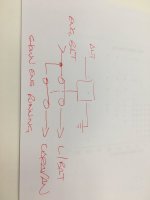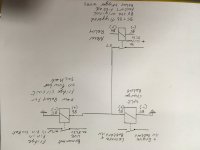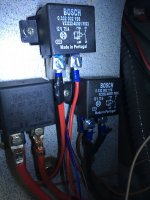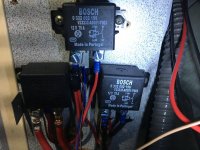Padraic
Lifetime VIP Member
Hi all, I'm looking for some advice on the split charge system. Some background info first.
A few months ago I fitted a Cyrix dual voltage sensing split charge relay, in order to enable charging of leisure battery and engine battery when on hook-up. However, after researching leisure batteries, I learned that they require different charging profiles than lead acid batteries, so I then decided to remove the dual voltage sensing split charge relay and revert back to the standard system.
In the future I plan to fit a Ctek mains charger like Sidepod did for charging the engine battery when on hook-up.
So I also recently fitted a tow-bar and a 13 pin socket. In order to have it wired up correctly, I fitted a permanent + supply and a engine running + supply.
I've wired the engine running + supply via a relay, however I'm struggling to find a suitable engine running trigger for the relay.
Firstly I just taped in to the connections for the split charge system, however that started to give an alternator warning on the MFD.
Second attempt was to use the D+ connection (this connection gives alternator voltage when the engine is running) from the fuse box under the dash. same result, alternator warning on the MFD.
So after some more research, it seems that the standard split charge relay is already fed from the D+ from the alternator.
This D+ connection, is only able to supply a low current, and when the second relay is connected, it draws too much current and puts the alternator in to fault and affects the charging of the engine battery.
As this seems to be the only correct way to enable switching of the split charge relay and relay for the engine running + feed to the 13 pin tow-bar socket, I want to find a solution.
So my plan is to use the D+ connection to switch on a small standard type relay. This will work okay as the D+ is already capable of switching on the one split charge relay.
This relay will in turn switch on the split charge relay and relay for the engine running + feed to the 13 pin tow-bar socket. With this set up, there should be no faults from the alternator and both relays should switch on when the engine is running and the alternator is supplying the required voltage.
Should I source a relay with a resistor to limit the current flow through the relay, or a relay with a diode to dissipate the stored energy in the coil?
Any suggestions or opinions on this plan of mine would be greatly appreciated.
Regards Padraic.
A few months ago I fitted a Cyrix dual voltage sensing split charge relay, in order to enable charging of leisure battery and engine battery when on hook-up. However, after researching leisure batteries, I learned that they require different charging profiles than lead acid batteries, so I then decided to remove the dual voltage sensing split charge relay and revert back to the standard system.
In the future I plan to fit a Ctek mains charger like Sidepod did for charging the engine battery when on hook-up.
So I also recently fitted a tow-bar and a 13 pin socket. In order to have it wired up correctly, I fitted a permanent + supply and a engine running + supply.
I've wired the engine running + supply via a relay, however I'm struggling to find a suitable engine running trigger for the relay.
Firstly I just taped in to the connections for the split charge system, however that started to give an alternator warning on the MFD.
Second attempt was to use the D+ connection (this connection gives alternator voltage when the engine is running) from the fuse box under the dash. same result, alternator warning on the MFD.
So after some more research, it seems that the standard split charge relay is already fed from the D+ from the alternator.
This D+ connection, is only able to supply a low current, and when the second relay is connected, it draws too much current and puts the alternator in to fault and affects the charging of the engine battery.
As this seems to be the only correct way to enable switching of the split charge relay and relay for the engine running + feed to the 13 pin tow-bar socket, I want to find a solution.
So my plan is to use the D+ connection to switch on a small standard type relay. This will work okay as the D+ is already capable of switching on the one split charge relay.
This relay will in turn switch on the split charge relay and relay for the engine running + feed to the 13 pin tow-bar socket. With this set up, there should be no faults from the alternator and both relays should switch on when the engine is running and the alternator is supplying the required voltage.
Should I source a relay with a resistor to limit the current flow through the relay, or a relay with a diode to dissipate the stored energy in the coil?
Any suggestions or opinions on this plan of mine would be greatly appreciated.
Regards Padraic.



















